| # | Name | Photo | Date of rank [1] | Position [2] | Yrs [3] | Commission [4] | YC [5] | Notes [6] |
|---|
| 1 | David G. Farragut |  | 25 Jul 1866 | | 4 | 1810 (warrant) | 56 | (1801–1870) Brother-by-adoption of Navy four-star admiral David D. Porter Jr. |
| 2 | David D. Porter Jr. |  | 15 Aug 1870 | - Admiral of the Navy, 1870–1891.
- Head, Board of Inspection, 1877–1891.
| 21 | 1829 (warrant) | 41 | (1813–1891) Superintendent, U.S. Naval Academy, 1865–1869. Brother-by-adoption of Navy four-star admiral David G. Farragut. |
| 3 | George Dewey |  | 2 Mar 1899 | | 18 | 1858 (USNA) | 41 | (1837–1917) Promoted to admiral, 8 Mar 1899 but was promoted to Admiral of the Navy, 24 Mar 1903, with retroactive date of rank 2 Mar 1899. Candidate for Democratic Party nomination for U.S. President, 1900. |
| 4 | Frank F. Fletcher |  | 10 Mar 1915 | | 2 | 1875 (USNA) | 40 | (1855–1928) [7] Awarded Medal of Honor, 1914. Uncle of Navy four-star admiral Frank J. Fletcher. |
| 5 | Thomas B. Howard |  | 11 Mar 1915 | | 1 | 1873 (USNA) | 42 | (1854–1920) [7] Superintendent, U.S. Naval Observatory, 1917–1919. |
| 6 | Walter C. Cowles |  | 12 Mar 1915 | | 1 | 1873 (USNA) | 42 | (1853–1917) [7] |
| 7 | Albert G. Winterhalter |  | 9 Jul 1915 | | 2 | 1877 (USNA) | 38 | (1856–1920) [7] |
| 8 | Cameron M. Winslow |  | 13 Sep 1915 | | 1 | 1875 (USNA) | 40 | (1854–1932) [7] |
| 9 | Henry T. Mayo |  | 19 Jun 1916 | | 3 | 1876 (USNA) | 41 | (1857–1937) [7] [8] Governor, U.S. Naval Home, 1924–1928. |
| 10 | William B. Caperton |  | 28 Jul 1916 | | 3 | 1875 (USNA) | 41 | (1855–1941) [7] [8] Special Representative of the President in Brazil, 1918. |
| 11 | William S. Benson |  | 29 Aug 1916 | | 3 | 1877 (USNA) [9] | 39 | (1855–1932) [7] [8] Chairman/Commissioner, U.S. Shipping Board, 1919–1928. |
| 12 | Austin M. Knight |  | 4 Apr 1917 | | 1 | 1873 (USNA) [9] | 44 | (1854–1927) [7] President, Naval War College, 1913–1917. Brother of Seattle Mayor Bertha Knight Landes. |
| 13 | William S. Sims |  | 4 Dec 1918 | | 2 | 1880 (USNA) [9] | 38 | (1858–1936) [7] [8] President, Naval War College, 1917; 1919–1922. Awarded Pulitzer Prize for History, 1921. |
| 14 | Henry B. Wilson Jr. |  | 30 Jun 1919 | | 2 | 1881 (USNA) [9] | 38 | (1861–1954) [7] [8] Superintendent, U.S. Naval Academy, 1921–1925. Father-in-law of U.S. Secretary of War Patrick J. Hurley. |
| 15 | Hugh Rodman |  | 1 Jul 1919 | | 2 | 1880 (USNA) [9] | 39 | (1859–1940) [7] [8] U.S. Minister and Envoy to Peru, 1921. |
| 16 | Albert Gleaves |  | 1 Sep 1919 | | 2 | 1877 (USNA) [9] | 42 | (1858–1937) [7] [8] Governor, U.S. Naval Home, 1928–1931. |
| 17 | Robert E. Coontz |  | 1 Nov 1919 | | 6 | 1885 (USNA) [9] | 34 | (1864–1935) [7] [8] Governor of Guam, 1912–1913. |
| 18 | Joseph Strauss |  | 4 Feb 1921 | | 1 | 1885 (USNA) [9] | 36 | (1861–1948) [7] [8] |
| 19 | Hilary P. Jones | 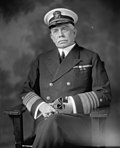 | 30 Jun 1921 | | 2 | 1884 (USNA) [9] | 37 | (1865–1939) [7] [8] |
| 20 | Edward W. Eberle |  | 5 Jul 1921 | | 6 | 1885 (USNA) [9] | 36 | (1864–1929) [7] Superintendent, U.S. Naval Academy, 1915–1919. |
| 21 | Edwin A. Anderson |  | 28 Aug 1922 | | 1 | 1882 (USNA) [9] | 40 | (1860–1933) [7] Awarded Medal of Honor, 1914. |
| 22 | Samuel S. Robison |  | 30 Jun 1923 | | 3 | 1888 (USNA) [9] | 35 | (1867–1952) [7] [10] Military Governor of Santo Domingo, 1921–1922; Superintendent, U.S. Naval Academy, 1928–1931; Superintendent, Admiral Farragut Academy, 1931–1948. Brother-in-law of Navy four-star admiral Charles F. Hughes. |
| 23 | Thomas Washington |  | 11 Oct 1923 | | 2 | 1887 (USNA) [9] | 36 | (1865–1954) [7] [10] Governor, U.S. Naval Home, 1931–1937. |
| 24 | Charles F. Hughes |  | 14 Oct 1925 | | 5 | 1888 (USNA) [9] | 37 | (1866–1934) [7] Brother-in-law of Navy four-star admiral Samuel S. Robison; daughter married brother of Navy five-star admiral Chester W. Nimitz. |
| 25 | Clarence S. Williams |  | 14 Oct 1925 | | 2 | 1884 (USNA) [9] | 41 | (1863–1951) [7] [10] President, Naval War College, 1922–1925. |
| 26 | Richard H. Jackson |  | 4 Sep 1926 | | 1 | 1887 (USNA) [9] | 39 | (1866–1971) [7] [10] Distant cousin of Air Force four-star general Charles P. Cabell. |
| 27 | Henry A. Wiley |  | 8 Sep 1927 | - Commander in Chief, U.S. Fleet (CINCUS), 1927–1929.
| 2 | 1888 (USNA) [9] | 39 | (1867–1943) [7] Chairman/Commissioner, U.S. Maritime Commission, 1936–1940. |
| 28 | Mark L. Bristol |  | 9 Sep 1927 | | 2 | 1887 (USNA) [9] | 40 | (1868–1939) [7] U.S. High Commissioner, Turkey, 1919–1927. |
| 29 | Louis R. de Steiguer |  | 10 Sep 1927 | | 1 | 1889 (USNA) [9] | 38 | (1867–1947) [7] [10] |
| 30 | William V. Pratt |  | 26 Jun 1928 | | 5 | 1889 (USNA) [9] | 39 | (1869–1957) [7] [11] President, Naval War College, 1925–1927. |
| 31 | Louis M. Nulton |  | 21 May 1929 | | 1 | 1889 (USNA) [9] | 40 | (1869–1954) [7] [10] Superintendent, U.S. Naval Academy, 1925–1928. |
| 32 | Charles B. McVay Jr. |  | 9 Sep 1929 | | 2 | 1890 (USNA) [9] | 39 | (1868–1949) [7] [10] |
| 33 | Frank H. Schofield |  | 24 May 1930 | | 2 | 1890 (USNA) [9] | 40 | (1869–1942) [7] |
| 34 | Jehu V. Chase |  | 17 Sep 1930 | - Commander in Chief, U.S. Fleet (CINCUS), 1930–1931.
| 1 | 1890 (USNA) [9] | 40 | (1869–1937) [7] Great-grandfather of Navy four-star admiral James F. Caldwell Jr. |
| 35 | Montgomery M. Taylor |  | 1 Sep 1931 | | 2 | 1890 (USNA) [9] | 41 | (1869–1952) [7] [10] Grandnephew of U.S. President Zachary Taylor; distant cousin of Army four-star general Montgomery C. Meigs. |
| 36 | Richard H. Leigh |  | 15 Sep 1931 | - Commander, Battle Force, U.S. Fleet (COMBATFOR), 1931–1932.
- Commander in Chief, U.S. Fleet (CINCUS), 1932–1933.
| 2 | 1891 (USNA) [9] | 40 | (1870–1946) [7] [10] |
| 37 | Luke McNamee |  | 11 Aug 1932 | | 1 | 1892 (USNA) [9] | 40 | (1871–1952) [7] [10] Governor of Guam, 1907; Director of Naval Intelligence, 1921–1923; President, Naval War College, 1933–1934. |
| 38 | William H. Standley |  | 20 May 1933 | | 4 | 1895 (USNA) [9] | 38 | (1872–1963) [7] [11] [12] U.S. Ambassador to the Soviet Union, 1942–1943. |
| 39 | David F. Sellers | | 10 Jun 1933 | - Commander in Chief, U.S. Fleet (CINCUS), 1933–1934.
| 1 | 1894 (USNA) [9] | 39 | (1874–1949) [7] [10] Superintendent, U.S. Naval Academy, 1934–1938. |
| 40 | Joseph M. Reeves |  | 1 Jul 1933 | - Commander, Battle Force, U.S. Fleet (COMBATFOR), 1933–1934.
- Commander in Chief, U.S. Fleet (CINCUS), 1934–1936.
| 3 | 1894 (USNA) [9] | 39 | (1872–1948) [7] [10] [13] |
| 41 | Frank B. Upham |  | 18 Aug 1933 | | 2 | 1893 (USNA) [9] | 40 | (1872–1939) [7] Married aunt of Navy four-star admiral Robert B. Carney. |
| 42 | Frank H. Brumby |  | 15 Jun 1934 | | 1 | 1895 (USNA) [9] | 39 | (1874–1950) [7] [10] |
| 43 | Harris Laning |  | 1 Apr 1935 | | 1 | 1895 (USNA) [9] | 40 | (1873–1941) [7] President, Naval War College, 1930–1933; Governor, U.S. Naval Home, 1937–1941. |
| 44 | Orin G. Murfin |  | 4 Oct 1935 | | 1 | 1897 (USNA) [9] | 38 | (1876–1956) [7] [10] |
| 45 | William D. Leahy |  | 30 Mar 1936 | | 5 | 1897 (USNA) [9] | 39 | (1875–1959) [14] Promoted to fleet admiral, 15 Dec 1944. Governor of Puerto Rico, 1939–1940; U.S. Ambassador to France, 1941–1942. Wife's niece married Navy four-star admiral David W. Bagley. |
| 46 | Arthur J. Hepburn |  | 24 Jun 1936 | - Commander in Chief, U.S. Fleet (CINCUS), 1936–1938.
| 2 | 1897 (USNA) [9] | 39 | (1877–1964) [7] [10] |
| 47 | Harry E. Yarnell |  | 30 Oct 1936 | | 3 | 1897 (USNA) [9] | 39 | (1875–1959) [7] [10] [15] |
| 48 | Claude C. Bloch |  | 2 Jan 1937 | - Commander, Battle Force, U.S. Fleet (COMBATFOR), 1937–1938.
- Commander in Chief, U.S. Fleet (CINCUS), 1938–1940.
| 3 | 1899 (USNA) [9] | 38 | (1878–1967) [7] [16] |
| 49 | Edward C. Kalbfus |  | 29 Jan 1938 | | 1 | 1899 (USNA) [9] | 39 | (1877–1954) [7] [10] President, Naval War College, 1934–1936; 1939–1942. |
| 50 | James O. Richardson |  | 24 Jun 1939 | - Commander, Battle Force, U.S. Fleet (COMBATFOR), 1939–1940.
- Commander in Chief, U.S. Fleet (CINCUS), 1940–1941.
| 2 | 1902 (USNA) [9] | 37 | (1878–1974) [7] [16] Relieved, 1941. |
| 51 | Thomas C. Hart |  | 25 Jul 1939 | | 3 | 1897 (USNA) [9] | 42 | (1877–1971) [17] Superintendent, U.S. Naval Academy, 1931–1934; U.S. Senator from Connecticut, 1945–1946. |
| 52 | Harold R. Stark |  | 1 Aug 1939 | | 6 | 1903 (USNA) [9] | 36 | (1880–1972) |
| 53 | Charles P. Snyder |  | 6 Jan 1940 | | 1 | 1900 (USNA) [9] | 40 | (1879–1964) [7] [16] President, Naval War College, 1937–1939. |
| 54 | Husband E. Kimmel | 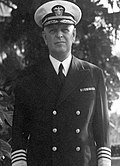 | 1 Feb 1941 | | 0 | 1904 (USNA) [9] | 37 | (1882–1968) [7] Relieved, 1941. Brother-in-law of Navy four-star admiral Thomas C. Kinkaid. |
| 55 | Ernest J. King |  | 1 Feb 1941 | | 3 | 1901 (USNA) [9] | 40 | (1878–1956) Promoted to fleet admiral, 17 Dec 1944. Awarded Congressional Gold Medal, 1946. Father-in-law of Air Force four-star general Frederic H. Smith Jr. |
| 56 | Chester W. Nimitz |  | 31 Dec 1941 | | 3 | 1905 (USNA) [9] | 36 | (1885–1966) Promoted to fleet admiral, 19 Dec 1944. Brother married daughter of Navy four-star admiral Charles F. Hughes. |
| 57 | Royal E. Ingersoll |  | 1 Jul 1942 | | 3 | 1905 (USNA) [9] | 37 | (1883–1976) |
| 58 | William F. Halsey Jr. |  | 18 Nov 1942 | | 2 | 1904 (USNA) [9] | 38 | (1882–1959) Promoted to fleet admiral, 4 Dec 1945. |
| 59 | Raymond A. Spruance |  | 16 Feb 1944 | - Commander, Central Pacific Force (COMCENPACFOR), 1943–1944.
- Commander, U.S. Fifth Fleet (COMFIFTHFLT), 1944–1945.
- Commander in Chief, U.S. Pacific Fleet/Commander in Chief, Pacific Ocean Areas/Military Governor of the Marshall, Caroline, and Mariana Islands (CINCPAC/CINCPOA), 1945–1946.
- President, Naval War College, 1946–1948.
| 4 | 1906 (USNA) [9] | 38 | (1886–1969) U.S. Ambassador to the Philippines, 1952–1955. |
| 60 | Jonas H. Ingram |  | 15 Nov 1944 | | 2 | 1909 (USNA) [9] | 35 | (1886–1952) Commissioner, All-America Football Conference, 1947–1949. Awarded Medal of Honor, 1914. |
| 61 | Frederick J. Horne |  | 15 Dec 1944 | | 1 | 1899 (USNA) [9] | 45 | (1880–1959) |
| 62 | Richard S. Edwards Jr. |  | 3 Apr 1945 | | 2 | 1907 (USNA) [9] | 38 | (1885–1956) |
| 63 | H. Kent Hewitt |  | 3 Apr 1945 | | 4 | 1907 (USNA) [9] | 38 | (1887–1972) |
| 64 | Thomas C. Kinkaid |  | 3 Apr 1945 | | 5 | 1908 (USNA) [9] | 37 | (1888–1972) Brother-in-law of Navy four-star admiral Husband E. Kimmel. |
| 65 | Richmond K. Turner |  | 24 May 1945 | | 2 | 1908 (USNA) [9] | 37 | (1885–1961) |
| 66 | Samuel M. Robinson |  | 27 Aug 1945 | | 1 | 1903 (USNA) [9] | 42 | (1882–1972) Administrator, Webb Institute of Naval Architecture, 1946–1951. First staff corps officer to attain rank of admiral. |
| * | John S. McCain Sr. |  | 6 Sep 1945 | | 0 | 1906 (USNA) [9] | 39 | (1884–1945) Father of Navy four-star admiral John S. McCain Jr.; grandfather of U.S. Senator John S. McCain III. |
| 67 | John H. Towers |  | 7 Nov 1945 | - Commander, U.S. Fifth Fleet (COMFIFTHFLT), 1945–1946.
- Commander in Chief, U.S. Pacific Fleet/Commander in Chief, Pacific Ocean Areas/Military Governor of the Marshall, Caroline, and Mariana Islands (CINCPAC/CINCPOA), 1946–1947.
- Commander in Chief, Pacific Command/Commander in Chief, U.S. Pacific Fleet/Military Governor of the Marshall, Caroline, and Mariana Islands (CINCPAC/CINCPACFLT), 1947.
- Chairman, General Board of the Navy, 1947.
| 2 | 1906 (USNA) [9] | 39 | (1885–1955) |
| 68 | DeWitt C. Ramsey |  | 28 Dec 1945 | | 4 | 1912 (USNA) | 33 | (1888–1961) |
| 69 | Louis E. Denfeld |  | 7 Jan 1946 | - Commander in Chief, Pacific Command/Commander in Chief, U.S. Pacific Fleet/Military Governor of the Marshall, Caroline, and Mariana Islands (CINCPAC/CINCPACFLT), 1947.
- Commander in Chief, Pacific Command/Commander in Chief, U.S. Pacific Fleet/High Commissioner, Trust Territory of the Pacific Islands (CINCPAC/CINCPACFLT), 1947.
- Chief of Naval Operations (CNO), 1947–1949.
| 2 | 1912 (USNA) | 34 | (1891–1972) [18] Candidate for Republican Party nomination for Governor of Massachusetts, 1950. Relieved, 1949. |
| 70 | Charles M. Cooke Jr. |  | 8 Jan 1946 | | 2 | 1910 (USNA) [9] | 36 | (1886–1970) |
| 71 | Marc A. Mitscher |  | 1 Mar 1946 | | 1 | 1910 (USNA) [9] | 36 | (1887–1947) Died in office. |
| 72 | Ben Moreell |  | 11 Jun 1946 | | 0 | 1917 (direct) | 29 | (1892–1978) |
| 73 | Richard L. Conolly |  | 23 Sep 1946 | - Commander, U.S. Naval Forces, Europe (COMNAVEUR), 1946.
- Commander, U.S. Naval Forces, Eastern Atlantic and Mediterranean (COMNAVEASTLANTMED), 1946–1947.
- Commander in Chief, U.S. Naval Forces, Eastern Atlantic and Mediterranean (CINCNAVEASTLANTMED), 1947–1948.
- Commander in Chief, U.S. Naval Forces, Eastern Atlantic and Mediterranean (CINCNELM), 1948–1950.
| 4 | 1914 (USNA) | 32 | (1892–1962) [19] President, Naval War College, 1950–1953; President, Long Island University, 1953–1962. |
| 74 | William H.P. Blandy |  | 3 Feb 1947 | | 3 | 1913 (USNA) | 34 | (1890–1954) |
| 75 | Arthur W. Radford |  | 7 Apr 1949 | | 8 | 1916 (USNA) | 33 | (1896–1973) Married aunt of Army four-star general Michael S. Davison. |
| 76 | Forrest P. Sherman |  | 2 Nov 1949 | | 2 | 1917 (USNA) | 32 | (1896–1951) Died in office. |
| 77 | William M. Fechteler |  | 1 Feb 1950 | | 6 | 1916 (USNA) | 34 | (1896–1967) |
| 78 | Robert B. Carney |  | 2 Oct 1950 | - Commander in Chief, U.S. Naval Forces, Eastern Atlantic and Mediterranean (CINCNELM), 1950–1951.
- Commander in Chief, Allied Forces Southern Europe/Commander in Chief, U.S. Naval Forces, Eastern Atlantic and Mediterranean (CINCSOUTH/CINCNELM), 1951–1952.
- Commander in Chief, Allied Forces Southern Europe (CINCSOUTH), 1952–1953.
- Chief of Naval Operations (CNO), 1953–1955.
| 5 | 1916 (USNA) | 34 | (1895–1990) Aunt married Navy four-star admiral Frank B. Upham. |
| 79 | Lynde D. McCormick |  | 22 Dec 1950 | | 4 | 1915 (USNA) | 35 | (1895–1956) [20] President, Naval War College, 1954–1956. |
| 80 | Donald B. Duncan |  | 9 Aug 1951 | | 5 | 1917 (USNA) | 34 | (1896–1975) Governor, U.S. Naval Home, 1957–1962. Brother-in-law of U.S. Secretary of Commerce Harry L. Hopkins. |
| 81 | Felix B. Stump | 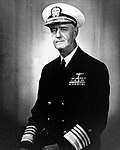 | 27 Jun 1953 | | 5 | 1917 (USNA) | 36 | (1894–1972) |
| 82 | Jerauld Wright |  | 6 Apr 1954 | | 6 | 1917 (USNA) | 37 | (1898–1995) U.S. Ambassador to China, 1963–1965. |
| 83 | John H. Cassady |  | 7 Apr 1954 | | 2 | 1918 (USNA) | 36 | (1896–1969) |
| 84 | Arleigh A. Burke |  | 6 Jun 1955 | | 6 | 1923 (USNA) | 32 | (1901–1996) Awarded Presidential Medal of Freedom, 1977. |
| 85 | Robert P. Briscoe |  | 30 Apr 1956 | | 3 | 1918 (USNA) | 38 | (1897–1968) |
| 86 | Walter F. Boone |  | 1 May 1956 | | 4 | 1920 (USNA) | 36 | (1898–1995) Superintendent, U.S. Naval Academy, 1954–1956; Deputy Associate Administrator for Defense Affairs, National Aeronautics and Space Administration, 1962–1968. |
| 87 | Harry D. Felt |  | 1 Sep 1956 | | 8 | 1923 (USNA) | 33 | (1902–1992) |
| 88 | Maurice E. Curts |  | 29 Apr 1957 | | 1 | 1919 (USNA) | 38 | (1898–1976) [19] |
| 89 | James L. Holloway Jr. |  | 1 Jan 1958 | | 1 | 1918 (USNA) | 40 | (1898–1984) Superintendent, U.S. Naval Academy, 1947–1950; Governor, U.S. Naval Home, 1962–1966. Father of Navy four-star admiral James L. Holloway III. |
| 90 | Herbert G. Hopwood |  | 1 Feb 1958 | | 2 | 1919 (USNA) | 39 | (1898–1966) |
| 91 | James S. Russell |  | 21 Jul 1958 | | 7 | 1926 (USNA) | 32 | (1903–1996) |
| 92 | Charles R. Brown | 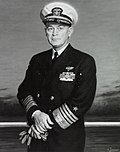 | 1 Jan 1959 | | 2 | 1921 (USNA) | 38 | (1899–1983) |
| 93 | Robert L. Dennison |  | 1 Feb 1959 | | 4 | 1923 (USNA) | 36 | (1901–1980) |
| 94 | Harold Page Smith |  | 1 Feb 1960 | | 5 | 1924 (USNA) | 36 | (1904–1993) Uncle of Navy four-star admiral Leighton W. Smith Jr. |
| 95 | John H. Sides |  | 1 Mar 1960 | | 3 | 1925 (USNA) | 35 | (1904–1978) |
| 96 | George W. Anderson Jr. |  | 1 Aug 1961 | | 2 | 1927 (USNA) | 34 | (1906–1992) U.S. Ambassador to Portugal, 1963–1966. |
| 97 | Claude V. Ricketts |  | 1 Nov 1961 | | 3 | 1929 (USNA) | 32 | (1906–1964) Died in office. |
| 98 | David L. McDonald |  | 1 Apr 1963 | | 4 | 1928 (USNA) | 35 | (1906–1997) |
| 99 | Charles D. Griffin |  | 26 Jun 1963 | | 5 | 1927 (USNA) | 36 | (1906–1996) |
| 100 | U.S. Grant Sharp Jr. |  | 27 Sep 1963 | | 5 | 1927 (USNA) | 36 | (1906–2001) Great-aunt married U.S. President Ulysses S. Grant. |
| 101 | Thomas H. Moorer |  | 26 Jun 1964 | | 10 | 1933 (USNA) | 31 | (1912–2004) |
| 102 | Horacio Rivero Jr. |  | 31 Jul 1964 | | 8 | 1931 (USNA) | 33 | (1910–2000) U.S. Ambassador to Spain, 1972–1974. |
| 103 | John S. Thach |  | 25 Mar 1965 | | 2 | 1927 (USNA) | 38 | (1905–1981) |
| 104 | Alfred G. Ward |  | 27 Mar 1965 | | 3 | 1932 (USNA) | 33 | (1909–1982) |
| 105 | Roy L. Johnson |  | 31 Mar 1965 | | 2 | 1929 (USNA) | 36 | (1906–1999) |
| 106 | John S. McCain Jr. |  | 1 May 1967 | | 5 | 1931 (USNA) | 36 | (1911–1981) Son of Navy four-star admiral John S. McCain Sr.; father of U.S. Senator John S. McCain III. |
| 107 | Ignatius J. Galantin |  | 19 May 1967 | | 3 | 1933 (USNA) | 34 | (1910–2004) |
| 108 | Ephraim P. Holmes | 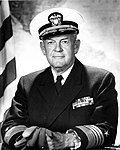 | 17 Jun 1967 | | 3 | 1930 (USNA) | 37 | (1908–1997) |
| 109 | John J. Hyland Jr. |  | 1 Dec 1967 | | 3 | 1934 (USNA) | 33 | (1912–1998) |
| 110 | Bernard A. Clarey |  | 17 Jan 1968 | | 5 | 1934 (USNA) | 34 | (1912–1996) |
| 111 | Waldemar F.A. Wendt |  | 12 Jul 1968 | | 3 | 1933 (USNA) | 35 | (1912–1997) |
| 112 | Elmo R. Zumwalt Jr. |  | 1 Jul 1970 | | 4 | 1942 (USNA) | 28 | (1920–2000) Democratic Party nominee for U.S. Senator from Virginia, 1976. Awarded Presidential Medal of Freedom, 1998. |
| 113 | Charles K. Duncan |  | 1 Sep 1970 | | 2 | 1933 (USNA) | 37 | (1911–1994) |
| 114 | Jackson D. Arnold |  | 14 Oct 1970 | | 1 | 1934 (USNA) | 36 | (1912–2007) First restricted line officer to attain rank of admiral. |
| 115 | Ralph W. Cousins |  | 1970-10-3030 Oct 1970 | | 5 | 1937 (USNA) | 33 | (1915–2009) |
| 116 | William F. Bringle | 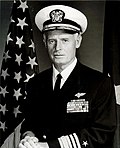 | 1 Jul 1971 | | 2 | 1937 (USNA) | 34 | (1913–1999) |
| 117 | Isaac C. Kidd Jr. |  | 1 Dec 1971 | | 7 | 1942 (USNA) | 29 | (1919–1999) |
| 118 | Richard G. Colbert |  | 1 Jun 1972 | | 1 | 1937 (USNA) | 35 | (1915–1973) President, Naval War College, 1968–1971. |
| 119 | Noel A.M. Gayler |  | 1 Sep 1972 | | 4 | 1935 (USNA) | 37 | (1914–2011) Director, National Security Agency, 1969–1972. |
| 120 | Maurice F. Weisner |  | 1 Sep 1972 | | 7 | 1941 (USNA) | 31 | (1917–2006) |
| 121 | James L. Holloway III |  | 1 Sep 1973 | | 5 | 1942 (USNA) | 31 | (1922–2019) Son of Navy four-star admiral James L. Holloway Jr. |
| 122 | Worth H. Bagley |  | 1 Sep 1973 | | 2 | 1947 (USNA) | 26 | (1924–2016) Son of Navy four-star admiral David W. Bagley; brother of Navy four-star admiral David H. Bagley; great-aunt married Navy five-star admiral William D. Leahy; great-aunt married U.S. Secretary of the Navy Josephus Daniels. |
| 123 | Hyman G. Rickover |  | 16 Nov 1973 | - Director, Naval Reactors Branch, Atomic Energy Commission/Deputy Commander for Nuclear Propulsion, Naval Ship Systems Command, 1966–1974.
- Director, Naval Reactors Branch, Atomic Energy Commission/Deputy Commander for Nuclear Propulsion, Naval Sea Systems Command, 1974–1975.
- Director, Division of Naval Reactors, Energy Research and Development Administration/Deputy Commander for Nuclear Propulsion, Naval Sea Systems Command, 1975–1977.
- Deputy Assistant Secretary for Naval Reactors, U.S. Department of Energy/Deputy Commander for Nuclear Propulsion, Naval Sea Systems Command, 1977–1982.
| 9 | 1922 (USNA) | 51 | (1900–1986) [21] Awarded Presidential Medal of Freedom, 1980; Congressional Gold Medal, 1958 and 1982. |
| 124 | Means Johnston Jr. |  | 25 Nov 1973 | | 2 | 1939 (USNA) | 34 | (1916–1989) |
| 125 | Harold E. Shear |  | 24 May 1974 | | 6 | 1942 (USNA) | 32 | (1918–1999) Administrator, U.S. Maritime Administration, 1981–1985. |
| 126 | John P. Weinel |  | 2 Aug 1974 | | 3 | 1939 (USNA) | 35 | (1916–2004) |
| 127 | Frederick H. Michaelis |  | 19 Apr 1975 | | 3 | 1940 (USNA) | 35 | (1917–1992) |
| 128 | David H. Bagley |  | 21 May 1975 | | 2 | 1943 (USNA) | 32 | (1920–1992) Son of Navy four-star admiral David W. Bagley; brother of Navy four-star admiral Worth H. Bagley; great-aunt married Navy five-star admiral William D. Leahy; great-aunt married U.S. Secretary of the Navy Josephus Daniels. |
| 129 | Stansfield Turner |  | 1 Sep 1975 | | 4 | 1946 (USNA) | 29 | (1923–2018) President, Naval War College, 1972–1974. |
| 130 | Daniel J. Murphy |  | 28 May 1976 | - Deputy to the Director of Central Intelligence for the Intelligence Community (D/DCI/IC), 1976–1977.
| 1 | 1943 (OCS) | 33 | (1922–2001) U.S. Deputy Undersecretary of Defense for Policy, 1977–1981; Chief of Staff to the U.S. Vice President, 1981–1985. |
| 131 | Thomas B. Hayward |  | 12 Aug 1976 | | 6 | 1947 (USNA) | 29 | (1924–2022) |
| 132 | Robert L. J. Long |  | 5 Jul 1977 | | 6 | 1943 (USNA) | 34 | (1920–2002) |
| 133 | Donald C. Davis |  | 9 May 1978 | | 3 | 1943 (USNA) | 35 | (1921–1998) |
| 134 | Alfred J. Whittle Jr. |  | 1 Aug 1978 | | 3 | 1945 (USNA) | 33 | (1924–1993) |
| 135 | Harry D. Train II |  | 1 Oct 1978 | | 4 | 1949 (USNA) | 29 | (1927– ) |
| 136 | James D. Watkins |  | 18 Sep 1979 | | 7 | 1949 (USNA) | 30 | (1927–2012) Chairman, Watkins Commission, 1987–1988; U.S. Secretary of Energy, 1989–1993. |
| 137 | William J. Crowe Jr. |  | 30 May 1980 | - Commander in Chief, Allied Forces Southern Europe (CINCSOUTH), 1980–1983.
- Commander in Chief, U.S. Naval Forces Europe/Commander in Chief, Allied Forces Southern Europe (CINCUSNAVEUR/CINCSOUTH), 1983.
- Commander in Chief, Pacific Command (CINCPAC), 1983.
- Commander in Chief, U.S. Pacific Command (USCINCPAC), 1983–1985.
- Chairman, Joint Chiefs of Staff (CJCS), 1985–1989.
| 9 | 1947 (USNA) | 33 | (1925–2007) Chairman, President's Intelligence Advisory Board, 1993–1994; U.S. Ambassador to the United Kingdom, 1994–1997. Awarded Presidential Medal of Freedom, 2000. |
| 138 | Bobby R. Inman |  | 12 Feb 1981 | | 1 | 1952 (OCS) | 29 | (1931– ) [22] Director of Naval Intelligence, 1974–1976; Director, National Security Agency, 1977–1981. First naval intelligence specialist to attain rank of admiral. |
| 139 | William N. Small |  | 1 Jul 1981 | | 4 | 1948 (USNA) | 33 | (1927–2016) |
| 140 | John G. Williams Jr. |  | 1 Jul 1981 | | 2 | 1947 (USNA) | 34 | (1924–1991) |
| 141 | George E.R. Kinnear II |  | 31 Jul 1981 | | 1 | 1948 (OCS) | 33 | (1928–2015) |
| 142 | Kinnaird R. McKee |  | 2 Mar 1982 | | 6 | 1951 (USNA) | 31 | (1929–2013) Superintendent, U.S. Naval Academy, 1975–1978. |
| 143 | Sylvester R. Foley Jr. |  | 28 May 1982 | | 3 | 1950 (USNA) | 32 | (1928–2019) U.S. Assistant Secretary of Energy for Defense Programs, 1985–1988. |
| 144 | Wesley L. McDonald |  | 1 Oct 1982 | | 3 | 1946 (USNA) | 36 | (1924–2009) |
| 145 | Ronald J. Hays |  | 29 Apr 1983 | | 5 | 1950 (USNA) | 33 | (1928–2021) |
| 146 | Steven A. White |  | 1 Aug 1983 | | 2 | 1952 (NROTC) | 31 | (1928–2021) Manager of Nuclear Power, Tennessee Valley Authority, 1986–1988. |
| 147 | Lee Baggett Jr. |  | 30 May 1985 | | 3 | 1950 (USNA) | 35 | (1927–1999) |
| 148 | James A. Lyons Jr. |  | 16 Sep 1985 | | 2 | 1952 (USNA) | 33 | (1927–2018) |
| 149 | Carlisle A.H. Trost |  | 4 Oct 1985 | | 5 | 1953 (USNA) | 32 | (1930–2020) |
| 150 | James B. Busey IV |  | 17 Oct 1985 | | 4 | 1954 (NAVCAD) | 31 | (1932–2023) Administrator, Federal Aviation Administration, 1989–1991; U.S. Deputy Secretary of Transportation, 1991–1992. |
| 151 | Arthur S. Moreau Jr. |  | 15 Nov 1985 | | 1 | 1953 (USNA) | 32 | (1931–1986) Died in office. |
| 152 | Frank B. Kelso II |  | 13 Jun 1986 | | 8 | 1956 (USNA) | 30 | (1933–2013) |
| 153 | Huntington Hardisty |  | 11 Mar 1987 | | 4 | 1952 (USNA) | 35 | (1929–2003) President, Naval War College, 1977. |
| 154 | Powell F. Carter Jr. |  | 1 Oct 1987 | | 4 | 1955 (USNA) | 32 | (1931–2017) |
| 155 | David E. Jeremiah |  | 1 Oct 1987 | | 7 | 1956 (OCS) | 32 | (1934–2013) |
| 156 | Leon A. Edney |  | 1 Oct 1988 | | 4 | 1957 (USNA) | 31 | (1935– ) |
| 157 | Bruce DeMars |  | 1 Nov 1988 | | 8 | 1957 (USNA) | 31 | (1935–2024) |
| 158 | James R. Hogg |  | 1 Dec 1988 | | 3 | 1956 (USNA) | 32 | (1934–2025) |
| 159 | Jonathan T. Howe | 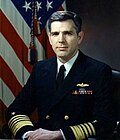 | 1 Jun 1989 | | 3 | 1957 (USNA) | 32 | (1935– ) U.S. Assistant Secretary of State for Politico-Military Affairs, 1982–1984; Special Representative of the U.N. Secretary General for Somalia, 1993–1994. |
| 160 | Charles R. Larson |  | 1 Mar 1990 | | 8 | 1958 (USNA) | 32 | (1936–2014) [23] Superintendent, U.S. Naval Academy, 1983–1986; Democratic Party nominee for Lieutenant Governor of Maryland, 2002. |
| 161 | Jerome L. Johnson |  | 1 Jul 1990 | | 2 | 1956 (NROTC) | 34 | (1935– ) |
| 162 | Paul D. Miller |  | 1 Feb 1991 | | 3 | 1964 (OCS) | 27 | (1941– ) |
| 163 | William D. Smith |  | 22 Feb 1991 | | 2 | 1955 (USNA) | 36 | (1933–2020) |
| 164 | Robert J. Kelly |  | 1 Mar 1991 | | 3 | 1959 (USNA) | 32 | (1938– ) |
| 165 | Jeremy M. Boorda |  | 2 Mar 1992 | | 4 | 1962 (OCS) | 30 | (1938–1996) Died in office. |
| 166 | William O. Studeman |  | 9 Apr 1992 | | 3 | 1962 (NROTC) | 30 | (1940– ), Director of Naval Intelligence, 1985–1988; Director, National Security Agency, 1988–1992. Father of Navy rear admiral Michael W. Studeman. |
| 167 | Stanley R. Arthur |  | 6 Jul 1992 | | 3 | 1957 (NROTC) | 35 | (1935– ) [24] |
| 168 | Henry H. Mauz Jr. |  | 1 Aug 1992 | | 2 | 1959 (USNA) | 33 | (1936– ) |
| 169 | Henry G. Chiles Jr. |  | 14 Feb 1994 | | 2 | 1960 (USNA) | 34 | (1938– ) |
| 170 | William A. Owens |  | 1 Mar 1994 | | 2 | 1962 (USNA) | 32 | (1940– ) |
| 171 | Leighton W. Smith Jr. |  | 1 May 1994 | | 2 | 1962 (USNA) | 32 | (1939– ) Nephew of Navy four-star admiral Harold Page Smith. |
| 172 | Richard C. Macke |  | 1 Oct 1994 | | 2 | 1960 (USNA) | 34 | (1938–2022) [7] Relieved, 1996. |
| 173 | Ronald J. Zlatoper |  | 5 Oct 1994 | | 2 | 1963 (NROTC) | 31 | (1941–2022) |
| 174 | William J. Flanagan Jr. |  | 1 Nov 1994 | | 2 | 1964 (MMA) [25] | 30 | (1943– ) |
| 175 | Joseph W. Prueher |  | 1 Jun 1995 | | 4 | 1964 (USNA) | 31 | (1942– ) U.S. Ambassador to China, 1999–2001. |
| 176 | Jay L. Johnson |  | 1 Apr 1996 | | 4 | 1968 (USNA) | 28 | (1946– ) |
| 177 | Thomas J. Lopez |  | 31 Jul 1996 | | 2 | 1964 (NROTC) | 32 | (1940– ) |
| 178 | Frank L. Bowman |  | 1 Oct 1996 | | 8 | 1966 (NROTC) | 30 | (1944– ) |
| 179 | Harold W. Gehman Jr. |  | 1 Oct 1996 | | 4 | 1965 (NROTC) | 31 | (1942– ) |
| 180 | Archie R. Clemins |  | 1 Jan 1997 | | 2 | 1966 (NROTC) | 31 | (1943–2020) |
| 181 | J. Paul Reason |  | 1 Feb 1997 | | 2 | 1965 (USNA) | 32 | (1941– ) First African-American to achieve the rank of admiral. |
| 182 | Donald L. Pilling |  | 30 Oct 1997 | | 3 | 1965 (USNA) | 32 | (1943–2008) |
| 183 | Richard W. Mies |  | 1 Aug 1998 | | 3 | 1967 (USNA) | 31 | (1944– ) |
| 184 | Charles S. Abbot |  | 1 Sep 1998 | | 2 | 1966 (USNA) | 32 | (1945– ) Deputy Director, Office of Homeland Security, 2001–2003. |
| 185 | James O. Ellis |  | 1 Jan 1999 | | 5 | 1969 (USNA) | 30 | (1947– ) |
| 186 | Dennis C. Blair |  | 1 May 1999 | | 3 | 1968 (USNA) | 31 | (1946– ) President, Institute for Defense Analyses, 2003–2006; Director of National Intelligence, 2009–2010. |
| 187 | Vernon E. Clark |  | 1 Nov 1999 | | 6 | 1968 (OCS) | 31 | (1944– ) |
| 188 | Thomas B. Fargo |  | 1 Dec 1999 | | 6 | 1970 (USNA) | 29 | (1948– ) |
| 189 | Robert J. Natter |  | 1 Sep 2000 | | 3 | 1967 (USNA) | 33 | (1945– ) |
| 190 | William J. Fallon |  | 1 Nov 2000 | | 8 | 1967 (NROTC) | 33 | (1944– ) Resigned, 2008. |
| 191 | Gregory G. Johnson |  | 24 Oct 2001 | | 3 | 1969 (NROTC) | 32 | (1946– ) |
| 192 | Walter F. Doran |  | 4 May 2002 | | 3 | 1967 (NROTC) | 35 | (1945– ) |
| 193 | Edmund P. Giambastiani Jr. |  | 2 Oct 2002 | | 5 | 1970 (USNA) | 32 | (1948– ) |
| 194 | Michael G. Mullen |  | 28 Aug 2003 | | 8 | 1968 (USNA) | 35 | (1946– ) |
| 195 | John B. Nathman |  | 1 Dec 2004 | | 3 | 1970 (USNA) | 34 | (1948– ) |
| 196 | Timothy J. Keating |  | 1 Jan 2005 | | 5 | 1971 (USNA) | 34 | (1949– ) |
| 197 | Kirkland H. Donald |  | 1 Jan 2005 | | 8 | 1975 (USNA) | 30 | (1953– ) |
| 198 | Robert F. Willard |  | 18 Mar 2005 | | 7 | 1973 (USNA) | 32 | (1950– ) |
| 199 | Henry G. Ulrich III |  | 22 Jul 2005 | | 2 | 1972 (USNA) | 33 | (1950– ) |
| 200 | Gary Roughead |  | 1 Sep 2005 | | 6 | 1973 (USNA) | 32 | (1951– ) |
| 201 | James G. Stavridis |  | 18 Oct 2006 | | 7 | 1976 (USNA) | 30 | (1955– ) Dean, The Fletcher School of Law and Diplomacy, 2013–2018. |
| 202 | Patrick M. Walsh |  | 5 Apr 2007 | | 5 | 1977 (USNA) | 30 | (1955– ) |
| 203 | Eric T. Olson |  | 6 Jul 2007 | | 4 | 1973 (USNA) | 34 | (1952– ) First Navy SEAL to achieve the rank of admiral. |
| 204 | Jonathan W. Greenert |  | 29 Sep 2007 | | 8 | 1975 (USNA) | 32 | (1953– ) |
| 205 | Mark P. Fitzgerald |  | 30 Nov 2007 | | 3 | 1973 (NROTC) | 34 | (1951– ) |
| 206 | John C. Harvey Jr. |  | 24 Jul 2009 | | 3 | 1973 (USNA) | 36 | (1951– ) Virginia Secretary of Veterans and Defense Affairs, 2014–2017. |
| 207 | James A. Winnefeld Jr. |  | 19 May 2010 | | 5 | 1978 (NROTC) | 32 | (1956– ) Chair, President's Intelligence Advisory Board, 2022–2024. |
| 208 | Samuel J. Locklear III |  | 6 Oct 2010 | | 5 | 1977 (USNA) | 33 | (1954– ) |
| 209 | William H. McRaven |  | 8 Aug 2011 | | 3 | 1977 (NROTC) | 34 | (1955– ) Chancellor, University of Texas System, 2015–2018. |
| 210 | Mark E. Ferguson III |  | 22 Aug 2011 | | 5 | 1978 (USNA) | 33 | (1956– ) |
| 211 | Cecil D. Haney |  | 20 Jan 2012 | | 4 | 1978 (USNA) | 34 | (1955– ) |
| 212 | Bruce W. Clingan |  | 24 Feb 2012 | | 2 | 1977 (NROTC) | 34 | (1955– ) |
| 213 | William E. Gortney |  | 14 Sep 2012 | | 4 | 1977 (AOCS) | 35 | (1955– ) |
| 214 | John M. Richardson |  | 2 Nov 2012 | | 7 | 1982 (USNA) | 31 | (1960– ) |
| 215 | Harry B. Harris Jr. |  | 16 Oct 2013 | | 5 | 1978 (USNA) | 35 | (1956– ) [26] U.S. Ambassador to South Korea, 2018–2021. First Asian-American to achieve the rank of admiral. |
| 216 | Michael S. Rogers |  | 3 Apr 2014 | | 4 | 1981 (NROTC) | 33 | (1959– ) First Information Warfare Community officer to achieve the rank of admiral. |
| 217 | Michelle J. Howard |  | 1 Jul 2014 | | 3 | 1982 (USNA) | 32 | (1960– ) Chair, The Naming Commission, 2021–2022. First woman to achieve the rank of admiral. |
| 218 | Philip S. Davidson |  | 19 Dec 2014 | | 7 | 1982 (USNA) | 32 | (1960– ) |
| 219 | Scott H. Swift | 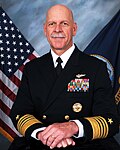 | 27 May 2015 | | 3 | 1979 (AOCS) | 36 | (1957– ) |
| 220 | James F. Caldwell Jr. |  | 14 Aug 2015 | | 9 | 1981 (USNA) | 34 | (1959– ) Great-grandson of Navy four-star admiral Jehu V. Chase. |
| 221 | Kurt W. Tidd |  | 14 Jan 2016 | | 2 | 1978 (USNA) | 38 | (1956– ) |
| 222 | William F. Moran |  | 31 May 2016 | | 3 | 1981 (USNA) | 35 | (1958– ) [27] |
| 223 | James G. Foggo III |  | 20 Oct 2017 | | 3 | 1981 (USNA) | 36 | (1959– ) |
| 224 | Christopher W. Grady |  | 4 May 2018 | | 7 | 1984 (NROTC) | 34 | (1962– ) |
| 225 | John C. Aquilino |  | 17 May 2018 | | 6 | 1984 (USNA) | 34 | (1961– ) [28] |
| 226 | Craig S. Faller |  | 26 Nov 2018 | | 3 | 1983 (USNA) | 35 | (1961– ) |
| 227 | Robert P. Burke |  | 10 Jun 2019 | | 3 | 1983 (NROTC) | 36 | (1962– ) |
| 228 | Michael M. Gilday |  | 22 Aug 2019 | | 4 | 1985 (USNA) | 34 | (1962– ) |
| 229 | Charles A. Richard |  | 18 Nov 2019 | | 3 | 1982 (NROTC) | 37 | (1959– ) |
| 230 | William K. Lescher |  | 29 May 2020 | | 2 | 1980 (USNA) | 40 | (1958– ) |
| 231 | Samuel J. Paparo Jr. |  | 5 May 2021 | | 4 | 1987 (NROTC) | 34 | (1964– ) |
| 232 | Daryl L. Caudle |  | 7 Dec 2021 | | 4 | 1985 (OCS) | 36 | (1963– ) |
| 233 | Stuart B. Munsch |  | 27 Jun 2022 | | 3 | 1985 (USNA) | 37 | (1962– ) |
| 234 | Lisa M. Franchetti |  | 2 Sep 2022 | | 3 | 1985 (NROTC) | 37 | (1964– ) Relieved, 2025. |
| 235 | James W. Kilby |  | 5 Jan 2024 | | 1 | 1986 (USNA) | 38 | (1963– ) |
| 236 | William J. Houston |  | 10 Jan 2024 | | 1 | 1990 (NROTC) | 34 | (1968– ) |
| 237 | Stephen T. Koehler |  | 5 Apr 2024 | | 1 | 1986 (NROTC) | 38 | (1964– ) |
| 238 | Alvin Holsey |  | 7 Nov 2024 | | 1 | 1988 (NROTC) | 36 | (1965– ) |
| 239 | Charles B. Cooper II |  | 8 Aug 2025 | | 0 | 1989 (USNA) | 36 | (1967– ) |
| 240 | Frank M. Bradley |  | 3 Oct 2025 | | 0 | 1991 (USNA) | 34 | |
| 241 | George M. Wikoff |  | 18 Nov 2025 | | 0 | 1990 (NROTC) | 35 | (1968– ) |
|
































































































































































































































































































